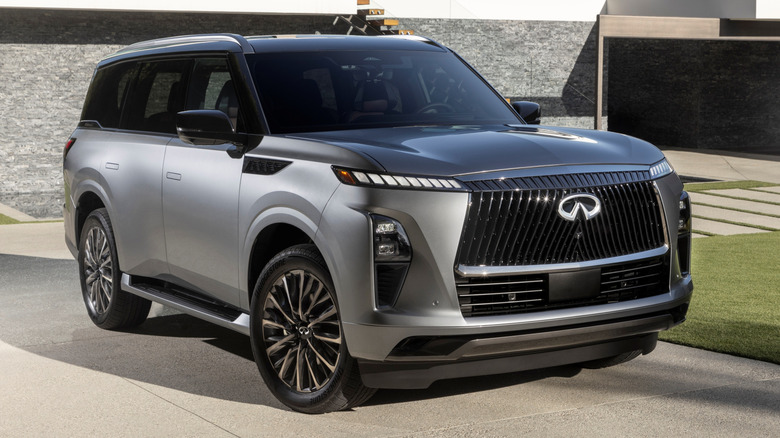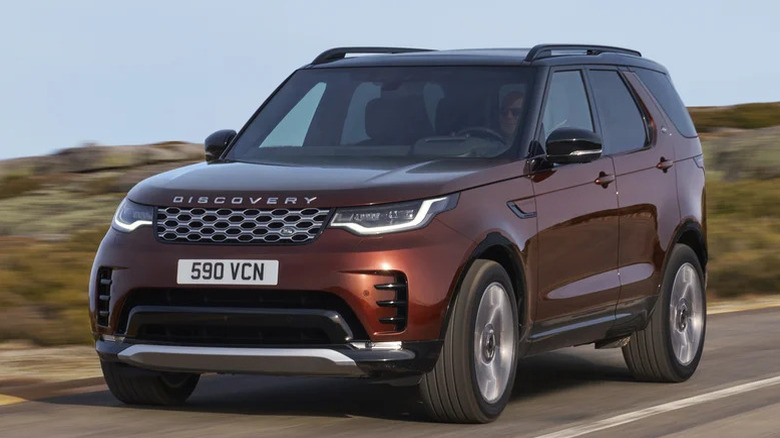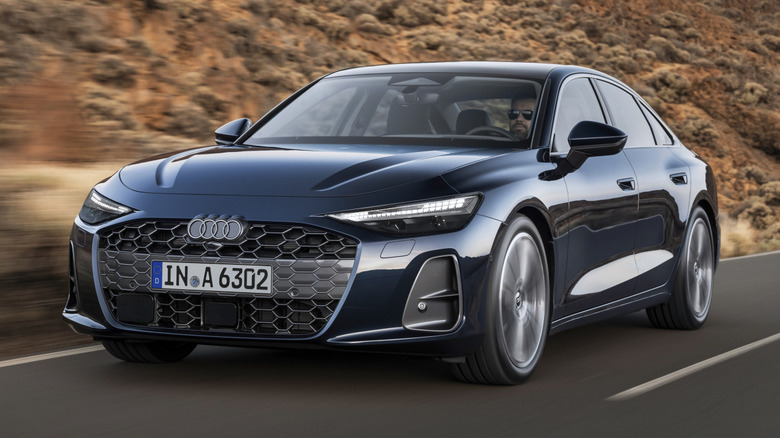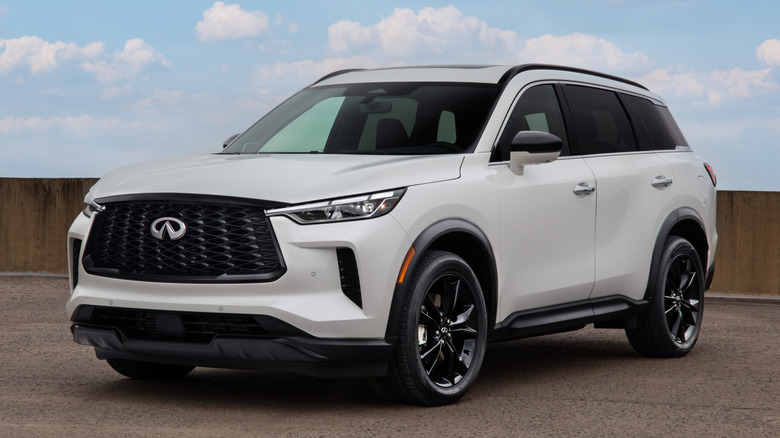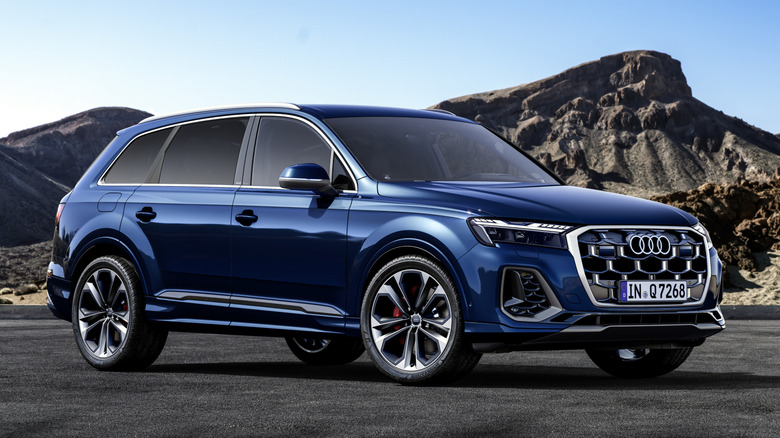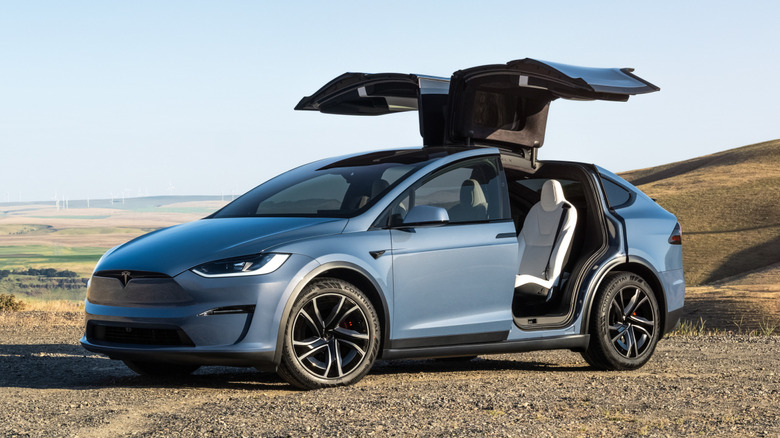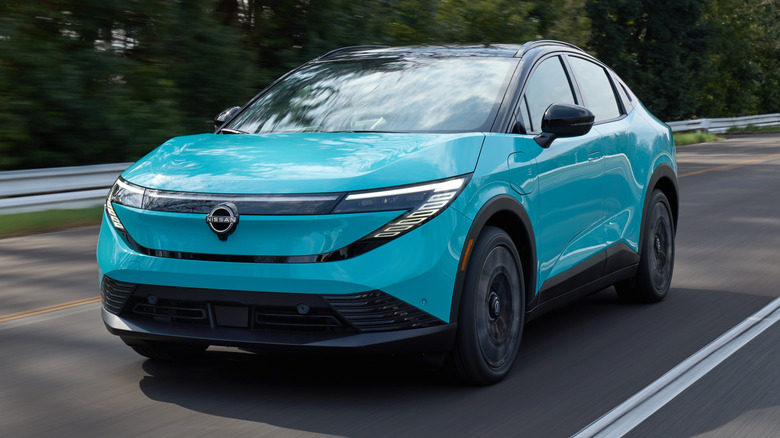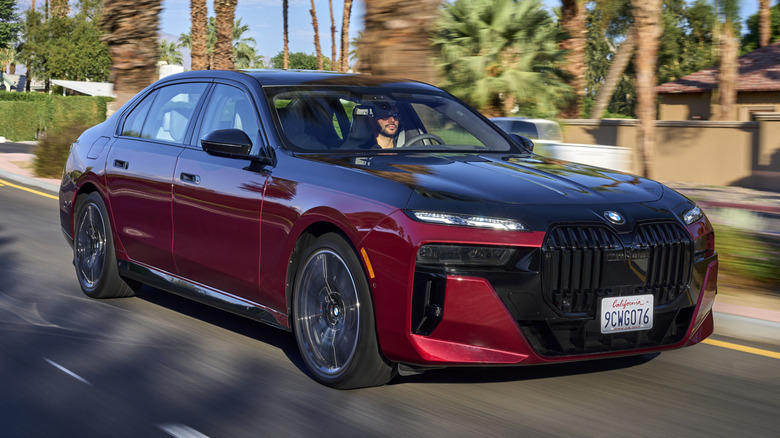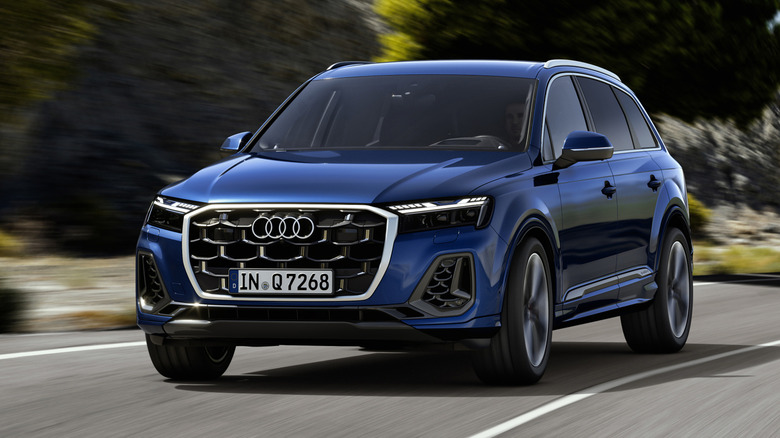13 Of The Worst Depreciating Cars In 2025
It's common knowledge that virtually all new cars lose a portion of their value as soon as they're driven off the dealership lot. They will also continue to lose value every year, although some cars lose value significantly faster than others. This can be for a variety of reasons. Many fast-depreciating cars are luxury vehicles that require greater maintenance, and they can become outdated more quickly as buyers flock towards the latest and greatest model. Others might gain a reputation for being particularly unreliable or out of step with used car market trends at the time.
Whatever the reason for their poor value retention, these 13 cars are all among the poorest performers on the market. Each one will lose at least 60% of its original value after five years on the road, according to research published by iSeeCars. If you're looking for a new car and hoping to sell it on in a few years, these models are worth steering well clear of. However, if you're looking for a well-depreciated used car bargain, they might be for you.
Land Rover Discovery — 60.9%
The Land Rover Discovery suffers from a flaw that isn't its fault. It's a competent, upscale SUV with plenty of attributes that make it worth buying new or used, but it also shares dealership space with the Defender and Range Rover models. The Defender is arguably the better-looking of the two and is pitched as being the most all-terrain capable model, while the Range Rover sub-brand remains Land Rover's most luxurious division. Within Range Rover, the company offers the entry-level Evoque, the sleek Velar, the athletic Range Rover Sport, and the full-fat, six-figure Range Rover.
With such a wealth of different models on offer from the Jaguar Land Rover stable, there are relatively few reasons to pick the Discovery. Its spacious interior and competitive economy might give it an edge for some buyers, but its patchy reliability reputation dents its appeal as a sensible family hauler. The Defender 110 also offers a seven-seat configuration, and although it's several thousand dollars more than an equivalent-spec seven-seat Discovery, it arguably makes up for the premium with its additional style points and off-road talents.
That lack of a unique selling point has likely contributed to the Discovery's poor resale value, with iSeeCars forecasting that it will lose 60.9% of its sticker price after five years on the road. That won't be welcome news to buyers, but it's still not the worst luxury SUV on the market in terms of value retention.
Audi A6 — 60.9%
Sedans aren't as in-demand among buyers as they used to be, with mid-size SUVs and pickup trucks being the most sought-after body styles. Add the Audi A6's reputation for expensive maintenance, and it's easy to see why it has one of the lowest value retention rates on the market. However, Audi is giving the model a major overhaul for the 2026 model year, launching an all-new generation that promises several key improvements over the outgoing car.
Buyers of the 2026 A6 will benefit from the car's revised styling, improved sound insulation, and efficiency — the A6's 0.23 drag coefficient makes it the most aerodynamically optimized combustion car in the brand's history. U.S. buyers miss out on the mild hybrid powertrain that's available in other markets, with the American A6 instead offering a 3.0L six-cylinder engine.
These upgrades will surely make the A6 appealing to new car buyers, but they likely won't do much to change its appeal among those looking for a used car. As such, it still seems unlikely that the latest version will hold its value significantly better than its predecessor.
Infiniti QX60 — 61.5%
After spending some time with the current-generation Infiniti QX60 in 2024, we came away less than convinced that the top trim was worth its price. Not only is the car mechanically identical to the Nissan Pathfinder, which costs almost half the price, but the top-trim QX60 was also around $20,000 more than the base-spec version of the car. Despite its comfort and the ample tech features — some of which worked better than others — we felt that its MSRP was too steep a premium to make the QX60 a competitive option.
It seems that used buyers also find the QX60's sticker price a bit steep, since they're only willing to pay a small fraction of that original price when the car hits five years old. According to iSeeCars, the QX60 loses 61.5% of its initial value after five years on the road, significantly more than its more affordable Nissan-badged sibling.
Audi Q7 — 61.6%
The Audi Q7 received a spruce-up for the 2025 model year, with tweaked styling, updated technology, and OLED taillights. Base models are offered with a 261-horsepower 2.0-liter turbo-four engine, while higher-spec models get a 3.0-liter V6 making 335 horsepower. The car's generously sized interior and seven-seat configuration are unchanged from before. Also likely to remain unchanged is the Q7's ability to shed its value rapidly over its first few years on the road. According to iSeeCars, buyers can expect to see their car lose 61.6% of its original sticker price after five years.
That might sound like a lot, but it isn't an unusual figure for a luxury SUV. Rival models from the likes of Cadillac, Range Rover, and Infiniti all hold even less of their value over the same time period. However, the Q7's German luxury SUV rivals from BMW and Mercedes-Benz offer better value retention, and are arguably the smarter pick for buyers looking to hold onto as much of their cash as possible when it comes time to resell.
Audi A8 L — 62.7%
Despite having last received a mid-life refresh in 2022, Audi hasn't given the 2026 A8 L any major updates. Instead, its tweaks are limited to only package changes, as well as the addition of a single new paint color, Daytona Gray pearl effect.
The changes are unlikely to give buyers any reason to buy the A8 over its leading rival, the Mercedes-Benz S-Class, which remains the benchmark for tech and luxury. The S-Class also suffers from slightly less rapid depreciation than the Audi, with the latter losing 62.7% of its value over five years. Still, the S-Class is far from a top performer in that regard, and can be expected to lose 60.7% of its original price over the same period.
Reports previously suggested that an all-electric A8 would be arriving as soon as next year. However, a tariff-related sales slump in the U.S. and an internal restructuring announced in late 2024 have left the brand's plans uncertain. To date, no official release date of the next-generation A8 has been confirmed.
Land Rover Range Rover — 62.9%
The range-topping Range Rover remains a uniquely British take on the luxury SUV, and it carries over many of the quirks and drawbacks of previous generations. It's still far from the most reliable SUV on the market, although JD Power gives the 2025 model an "Average" reliability rating. It's also not the cheapest to maintain, even by luxury car standards, and buyers can still expect to lose an awful lot of money when it comes time to resell.
Analysis from iSeeCars predicts that a Range Rover will lose 62.9% of its value on average over the course of five years. Even an entry-level example will cost over $100,000, while a long-wheelbase Range Rover SV can cost north of $250,000. It's enough to make the Range Rover palatable only to those for whom price and depreciation are mere side notes. Evidently, there are plenty of buyers who fit that description, as JLR delivered record profits in 2024, with the Range Rover division being particularly successful.
Cadillac Escalade ESV — 62.9%
If the Range Rover is the quintessential British luxury SUV, then the Cadillac Escalade is surely its American counterpart. It features all the typical trappings of an American luxury barge, and in its flagship V-Series guise, dials the performance up to equally over-the-top levels. Both the standard-sized Escalade — at least, standard-sized in this context — and the ESV depreciate quickly, but the ESV depreciates slightly quicker. Buyers can expect to lose 62.9% of their original investment over the course of half a decade.
Despite the excess, our reviewer reported thoroughly enjoying their time behind the wheel of the Escalade V-Series, simply because of how ludicrous it was. Its growling exhaust and surprisingly rapid straight-line speed made its heft even more outlandish, while its economy figures were predictably dire. However, for buyers with enough cash to burn, it's easy to see the appeal of Cadillac's biggest and boldest SUV.
Tesla Model X — 63.4%
The luxury EV market might be rapidly changing, but Tesla hasn't made any significant changes to the Model X for 2026. Granted, there are some minor tweaks, such as a new paint color, revised suspension bushings, and improved sound damping, but nothing that's notable enough to sway buyers away from the Model X's rivals. Tesla didn't give the car any big upgrades in 2025, nor in 2024. In fact, the Model X's styling hasn't really changed much at all since it debuted for the 2017 model year.
Another thing that hasn't changed is the car's ability to rapidly lose value. According to iSeeCars, the Model X will lose 63.4% of its value after five years on the road. While the car's maintenance costs are generally lower than many other, similarly value-shedding cars, concerns about the cost of one-off repairs and lingering worries about build quality likely help keep the Model X's resale value lower than its competitors.
Nissan Leaf — 64.1%
Take a glance at the new 2026 Nissan Leaf, and it's not immediately clear which one of the automaker's cars you're looking at. It shares more design similarities with the now-discontinued Ariya than it does with its immediate predecessor, and boasts far better range too. Depending upon the trim, the 2026 Leaf can travel as far as 303 miles on a single charge, a figure that's competitive with most of its rivals.
However, the five-year-old Nissan Leaf that was used to calculate SeeCars' rankings is a very different car. In its base-spec form, it was only rated for 149 miles on a charge, while the Leaf Plus offered 226 miles. The base Leaf's range was already low when it was new, and five years of battery degradation will have pushed it even further into impractical territory for many drivers. As a result, its resale value is very low, with the car losing 64.1% of its original value.
BMW 5-Series — 64.7%
BMW's executive sedans lose value particularly fast, with the electrified version of the 5-Series losing slightly more value than its ICE counterpart, according to iSeeCars data. Buyers of a 5-Series hybrid will lose 64.7% of the initial investment on average over half a decade.
The latest generation of the 5-Series debuted for the 2024 model year, with both ICE and all-electric variants on offer. The 530i xDrive impressed us, particularly for its equipment and interior design. However, our reviewer felt that the 540i was a more appealing option overall for those with the additional budget.
The all-electric i5 does a similarly commendable job of keeping the satisfying driving dynamics and solid build quality of previous cars. Which one to pick comes down to personal preferences regarding fueling or charging more than any big differences between the two sibling models, but with either one, buyers shouldn't expect to see much of their money back.
Infiniti QX80 — 65.0%
The luxury SUV market is an extremely competitive one, and the 2025 Infiniti QX80 is not the most memorable car in the segment. There's still plenty to like, though, with the SUV's upscale upholstery and ample interior tech making the cabin a great place to be. We also felt that the latest QX80 was an improvement over the previous generation car. However, that might not be enough to significantly change its five-year resale value. According to iSeeCars, the QX80 loses 65% of its value over that period.
That's a bigger drop than any other luxury SUV included in the study, even the notoriously fast-depreciating SUVs like the Range Rover and Cadillac Escalade. However, it's not bad news for everyone: buyers looking for a well-depreciated luxury people mover shouldn't overlook the QX80. Infiniti sold over 16,000 examples of the car in 2020, and shifted another 12,500 examples in 2021, so there should be plenty of inventory around for bargain hunters to find a keenly-priced example in good condition.
Tesla Model S — 65.2%
Even the cheapest Tesla Model S now sports a price tag close to six figures, while the Plaid is comfortably into six-figure territory. With that luxury-level pricing, it shouldn't be surprising to find out that the Model S also suffers from luxury-level depreciation.
The Tesla has steadily accrued more competitors every year that it's been on sale, but its performance figures are still comfortably among the best in its class. The all-wheel drive model offers 410 miles of range, while the Plaid's straight-line performance is its trump card, with a 0-60 mph time of just 1.99 seconds.
Even with such a first-rate spec sheet, the Model S isn't in high demand with used buyers. The Model 3 is practical and capable enough for most drivers, and it's significantly cheaper. Aside from the Model S' performance party tricks, there isn't much reason for used buyers to upgrade to Tesla's flagship passenger car.
BMW 7-Series — 67.1%
The current generation of the BMW 7-Series is one of the brand's most polarizing cars for years, with an attention-grabbing design that enlarges its signature kidney grilles to new extremes. If you can look past its face, it's also a very polished luxury barge, with enough gadgets to keep tech geeks happy and the wafting ride that's traditional in the luxury sedan segment. Most 7-Series buyers won't be fussed about its price tag, and can afford to upgrade to the latest version of the car every few years without worrying about pesky things like resale values.
Meanwhile, the pool of buyers willing to cough up the cash for a used luxury sedan is a small one. As a result, the 7-Series falls in value exceptionally fast, with iSeeCars recording an average value loss of 67.1% over the course of five years. Only the now-discontinued Jaguar I-Pace recorded a larger drop — a whopping 72.2% — but since the latter is not available as a 2025 model, the BMW takes the unfortunate title of being the fastest depreciating new car on sale today.
How we selected these fast depreciating cars
This list uses depreciation data from iSeeCars, which analyzed over 800,000 used car listings that were sold between March 2024 and February 2025 to determine which five-year-old cars sold for the smallest proportion of their sticker value. Based on this methodology, the study did not consider models that launched after the 2020 model year. For this roundup, we have only included car models that can be bought new in 2025, either as a 2025 or 2026 model year.
